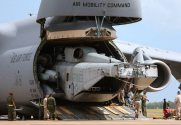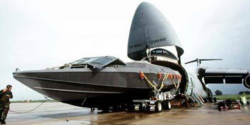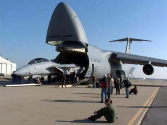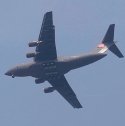You are using an out of date browser. It may not display this or other websites correctly.
You should upgrade or use an alternative browser.
You should upgrade or use an alternative browser.
China's transport, tanker & heavy lift aircraft
- Thread starter Totoro
- Start date
photo from a year ago
TerraN_EmpirE
Tyrant King
Why bother? There are very very few things a C5 sized aircraft can do that a C17 sized one cannot.
The U.S. has modernized its C5s but only a small number and this was done mostly to supplement the C17 fleet.
the Russians have maintained a number of AN124 but mostly because they don’t have the capability to replace them.
from the practical perspective building out more Y20
The U.S. has modernized its C5s but only a small number and this was done mostly to supplement the C17 fleet.
the Russians have maintained a number of AN124 but mostly because they don’t have the capability to replace them.
from the practical perspective building out more Y20
Because Y20 is not in the same class as C17. There are a lot of equipments can be fit into C17 but not in Y20, even their load capacity is not that far apart.Why bother? There are very very few things a C5 sized aircraft can do that a C17 sized one cannot.
The U.S. has modernized its C5s but only a small number and this was done mostly to supplement the C17 fleet.
the Russians have maintained a number of AN124 but mostly because they don’t have the capability to replace them.
from the practical perspective building out more Y20
TerraN_EmpirE
Tyrant King
Well true Y20 is still young and with engine upgrades and other modernization that window will close. It’s not a huge step between the two.
Where as it’s a large step between C5 and C17 sized lifters.
capacity wise
Y9 is 25,000kg
A400M is 37,000kg
Y20 is about 66,000 kgs
C17 is about 77,500 kgs
C5 is 127,500 it’s almost double. Yet in practice there is very few military cargo payloads that need that difference.
If this is just a Y20 modernization then it wouldn’t sport “Y40” or be compared to C5.
Where as it’s a large step between C5 and C17 sized lifters.
capacity wise
Y9 is 25,000kg
A400M is 37,000kg
Y20 is about 66,000 kgs
C17 is about 77,500 kgs
C5 is 127,500 it’s almost double. Yet in practice there is very few military cargo payloads that need that difference.
If this is just a Y20 modernization then it wouldn’t sport “Y40” or be compared to C5.
The Y-20 and C-17 contrast with each other more in terms of cargo compartment size than payload capacity.Because Y20 is not in the same class as C17. There are a lot of equipments can be fit into C17 but not in Y20, even their load capacity is not that far apart.
I made a post in this thread sometime ago, which compares the cargo compartment capacities for the Y-20 and C-17 through using several commonly carried (or expected to be commonly carried) land vehicles of the PLA by these airlifters (alongside the Il-76):
1. Il-76: 20.00m long x 3.45m wide x 3.40m high.
2. Y-20: >20.00m long x ~4.00m wide x ~4.00m high.
3. C-17: 25.96m long x 5.49m wide x 3.96-4.10m high.
And by using these PLA land vehicles to represent the different vehicle size categories for ease of comprehension:
1. Small-size: CSK181 MRAP, which is 5.65m long x 2.12m wide x 2.38m high.
2. Medium-size: VN1 APC, which is 7.80m long x 3.00m wide x 3.20m high.
3. Large-size: HT-233 radar vehicle, which is 15.00m long x 3.05m wide x 3.95m high, plus HQ-9 launcher vehicle, which is 13.00m long x 3.05m wide x 3.84m high.
Continuing by doing some rough Tetris, and here're the results:
1. For small-size (CSK181):
- Il-76 can carry 3x;
- Y-20 can carry 3x; and
- C-17 can carry 6x (2 rows of 3x each).
2. For medium-size (VN1):
- Il-76 can carry 3x;
- Y-20 can carry 3x; and
- C-17 can carry 3x.
3. For large-size (HT-233 and HQ-9 launcher):
- Il-76 can carry none (too big);
- Y-20 can carry 1x; and
- C-17 can carry 1x.
So, here's the analysis:
1. While the Y-20 certainly can carry 6x CSK181 based on payload weight capacity alone, yet the smaller width of the Y-20's cargo compartment compared to the C-17's means that those extra payload weight capacity available for the Y-20 is wasted;
2. The Y-20 is able to carry the HT-233 and HQ-9 launcher, but only barely when taking height into account; and
3. Due to the insufficient height of the cargo compartment of the Il-76, the payload weight capacity of the Il-76 means nothing as it is incapable of fitting both the HT-233 and the HQ-9 launcher inside of it.
If anything, this shows that while carrying small-sized land vehicles can be a greater disadvantage for the Y-20 vis-a-vis Y-20's smaller cargo compartment compared to the C-17 - The disadvantage gradually diminished with medium-sized and large-sized land vehicles, as the Y-20 and C-17 broadly carry the same number of land vehicles in both these categories.
(In fact, the C-17 slightly loses to the Y-20 in terms of cargo compartment height due to its wing box which protruded into the cargo compartment.)
Therefore, if anything - China's next-gen large airlifter should focus on the suitable expansion of the cargo compartment dimension compared to the Y-20, with particular focus on the width and height of its cargo compartment in order to fit the wider and taller PLA vehicles that are expected in the future (e.g. PLA's command, radar & sensor, and launcher vehicles for mid-course/terminal ABM/AHM system).
In the meantime - While developing a very large airlifter in the C-5/An-124 category certainly does have its own merit, yet as @TerraN_EmpirE has pointed out above, the merit may be rather limited in scope and potential to become truly justifiable for R&D resources to be dedicated towards it, at least in the short-to-medium term. That's probably also why both the US and Russia has no solid plans to develop direct successors to their C-5 and An-124, respectively.
In fact, airlifters in the C-5/An-124 category don't have significantly higher cargo compartment cellings than airlifters in the C-17/Y-20 category, while having a wider cargo compartment than the C-17 isn't as demanding either:
So there's that.1. C-5: 37.0m long x 5.8m wide x 4.1m high.
2. An-124: 36.5m long x 6.4m wide x 4.4m high.
Last edited:
There are a few cases when you would need a C-5-like aircraft to airlift something. But those are quite rare. Here are the photos of a CH-53E, a special ops boat and a fighter fuselage getting cargoed.The Y-20 and C-17 contrast with each other more in terms of cargo compartment size than payload capacity.
I made a post in this thread sometime ago, which compares the cargo compartment capacities for the Y-20 and C-17 through using several commonly carried (or expected to be commonly carried) land vehicles of the PLA by these airlifters (alongside the Il-76):
If anything, this shows that while carrying small-sized land vehicles can be a greater disadvantage for the Y-20 vis-a-vis Y-20's smaller cargo compartment compared to the C-17 - The disadvantage gradually diminished with medium-sized and large-sized land vehicles, as the Y-20 and C-17 broadly carry the same number of land vehicles in both these categories.
(In fact, the C-17 slightly loses to the Y-20 in terms of cargo compartment height due to its wing box which protruded into the cargo compartment.)
Therefore, if anything - China's next-gen large airlifter should focus on the suitable expansion of the cargo compartment dimension compared to the Y-20, with particular focus on the width and height of its cargo compartment in order to fit the wider and taller PLA vehicles that are expected in the future (e.g. PLA's command, radar & sensor, and launcher vehicles for mid-course/terminal ABM/AHM system).
In the meantime - While developing a very large airlifter in the C-5/An-124 category certainly does have its own merit, yet as @TerraN_EmpirE has pointed out above, the merit may be rather limited in scope and potential to become truly justifiable for R&D resources to be dedicated towards it, at least in the short-to-medium term. That's probably also why both the US and Russia has no solid plans to develop direct successors to their C-5 and An-124, respectively.
In fact, airlifters in the C-5/An-124 category don't have significantly higher cargo compartment cellings than airlifters in the C-17/Y-20 category, while having a wider cargo compartment than the C-17 isn't as demanding either:
So there's that.



But these are ultimately niche missions and make up a tiny percantage of missions such an aircraft would do. The question ultimately boils down to these choices.
1- Just buy more Y-20s. For the same cargo, having more aircraft would be more demanding on infrastructure. But the Y-20 is something already exists. Furthermore, having more aircraft comes with the benefit of serving more locations simultaneously. Imagine two locations needing 50 tonnes of supplies each. 2 Y-20s are much better suited for that situation than a single C-5 is. Other plusses: More fleet resilience against attrition and breakdowns, more airfields are OK for use...
2- Develop a new larger aircraft. This is the expensive opinion by default as it involves the development of a whole new aircraft and the establishment of its sustainment infrastructure. The benefits would be the capability to airlift some niche cargo, some extra range and more efficient carrying of low density supplies.
Personally I can't rule out China developing a super heavy lifter. Yet, I don't think it is an urgent requirement. If there is an ongoing project, it is very likely a low priority project. PLA has other more pressing needs which it would rather to spend its resources on.
if you remember, Chinese almost finalized the main assembly line of AN-225 to build second unfinished aircraft in 2016.. first flight was expected in 2019... LOOLPersonally I can't rule out China developing a super heavy lifter. Yet, I don't think it is an urgent requirement. If there is an ongoing project, it is very likely a low priority project. PLA has other more pressing needs which it would rather to spend its resources on.
at the last moment America intervene and Ukraine government broke the agreement.. as per the source, Antonov even shared all drawings and prints with Xian aircraft. and this was the major reason why China wanted to purchase Motorsich.. AN-225 with D-18T engine..
Chinese always fascinated about super heavy lifter.
Zhu Qian, head of AVIC's large aircraft development office said in 2016, during Zhuhai air show
''China will develop transport jets that are even larger than the Y-20, like the US' Lockheed C-5 Galaxy and former Soviet Union's Antonov An-225 Mriya''
this statement comes directly from higher authority.. despite this, still we cannot be 100 percent sure about this project. but its true that, AVIC was extremely interested in super heavy lifter back then.
Unless China has to deploy it's assets to another continent or their domestic territory is the size of USSR, I don't see why they would need a C5 size plane.
Domestic needs can be satisfied with Y20.
Domestic needs can be satisfied with Y20.

